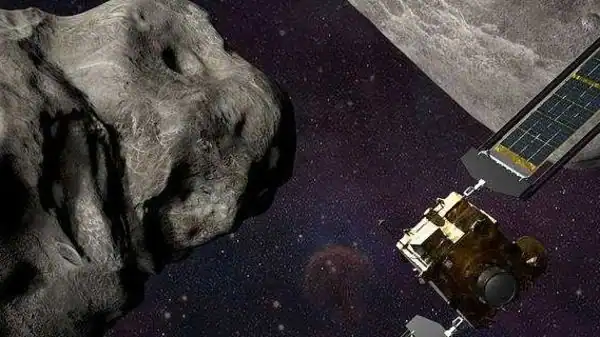
[ad_1]
The $324 million Double Asteroid Redirection Test, or DART, mission—a practice run for future efforts to protect Earth from collisions with asteroids and comets—is scheduled to launch aboard a SpaceX Falcon 9 rocket at 1:21 a.m. EST from Vandenberg Space Force Base in California. Next fall, after a journey of more than six million miles, the probe will crash at 15,000 miles an hour into Dimorphos, a tiny moonlet that orbits a larger asteroid called Didymos.
Mission planners expect the high-speed impact to alter the trajectory of the binary asteroid, which isn’t believed to pose a threat.
“For the first time, humanity will change the motion of a natural celestial body in space,” said DART program scientist Tom Statler of NASA. The project is managed for NASA by the Johns Hopkins University’s Applied Physics Laboratory in Laurel, Md.
Every day, Earth is showered with tons of cosmic debris, including chunks of ice, rock and iron that come at our planet like bricks from the junkyard of deep space. Most of these burn up harmlessly in the atmosphere, though spectacular exceptions to that rule have raised fears that a colossal space rock might one day be found to be on a collision course with Earth.
In 1908, for example, a mysterious space rock exploded over Siberia and leveled 830 square miles of forest. In 2013, a 65-foot asteroid blew apart 20 miles above Chelyabinsk, Russia. That airburst released more than 30 times the energy of the atomic bomb dropped on Hiroshima. It knocked people off their feet and blew out windows in thousands of buildings.
At the urging of Congress, astronomers have identified and tracked the trajectories of about 1,000 asteroids about 3,300 feet across or larger that periodically come near Earth’s orbit. None of these mountain-size space rocks is believed to pose a threat to our planet for at least the next several centuries, though there’s a remote chance an undetected asteroid could damage the planet.
“While this is not something that is very likely to happen, it is not something we want to completely ignore either,” said University of Arizona astronomer Amy Mainzer, who specializes in asteroid detection and planetary defense.
More than 90% of the potentially hazardous mountain-size asteroids have been identified, according to NASA. But only about 40% of potentially hazardous asteroids with diameters of 460 feet or more are believed to have been identified. There may be as many as 25,000 of these smaller asteroids, each of which might lay waste to an entire region if it were to strike our planet.
Asteroids 6 miles across or larger, like the one that wiped out most dinosaurs and torched much of the planet about 66 million years ago, are believed to strike only every 15 million years or so.
To facilitate the search for potentially hazardous asteroids, space agency officials in June approved the design of a new space-based infrared telescope called the Near-Earth Object Surveyor. The $500 million instrument is scheduled for launch in 2026.
“This is designed to find near-Earth asteroids large enough to cause regional damage,“ said Dr. Mainzer, who leads the project. “The question is to answer what could happen in the next 100 years. We hope the answer is nothing.”
Researchers have dreamed up various ways to eliminate the threat posed by asteroids, from obliterating them with nuclear-tipped missiles or burning them out of the sky with lasers to tugging them off course with the pull of gravity from a passing spacecraft. Some scientists have suggested unfurling solar sails on errant space rocks, so that the pressure of sunlight could alter their course.
The DART mission will test the simplest of these schemes—what space scientists call kinetic impact deflection—by steering the 1,200-pound, small-car-size probe into the moonlet with enough force to change its velocity by a fraction of a millimeter or so per second, according to Andy Rivkin, lead of the DART investigation team at the Applied Physics Laboratory. The action will be photographed by a free-flying, pint-size cubesat satellite designed by the Italian Space Agency, which the probe will release 10 days before the impact.
If the mission succeeds, NASA one day might use the impact technique to deflect an asteroid on a collision course with Earth.
“We are going to learn an incredible amount and be so much more prepared in the future if indeed a potential asteroid could pose a threat,” said Lori Glaze, director of NASA’s Planetary Science Division.
Never miss a story! Stay connected and informed with Mint.
Download
our App Now!!
[ad_2]